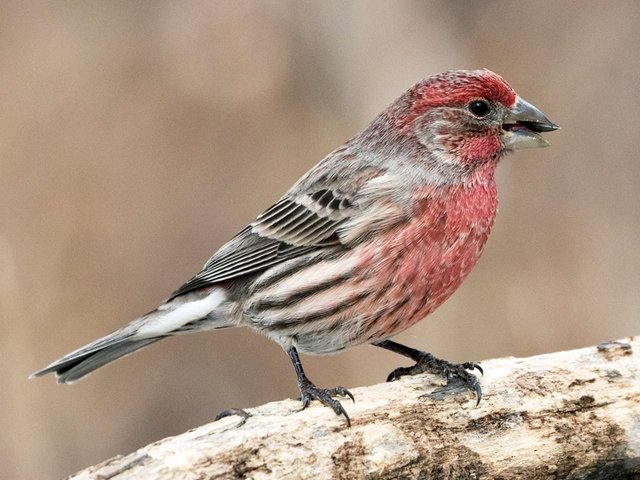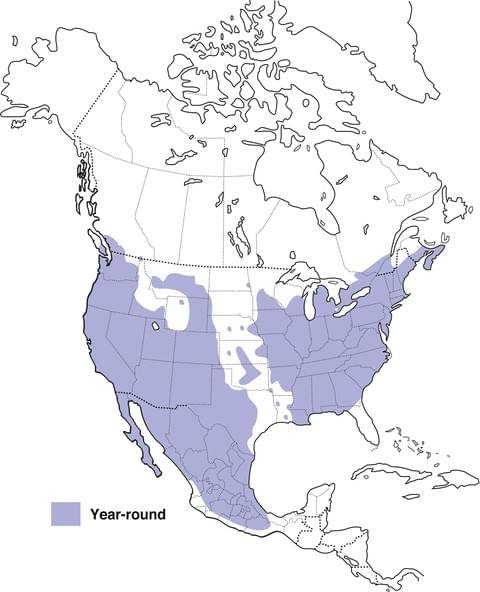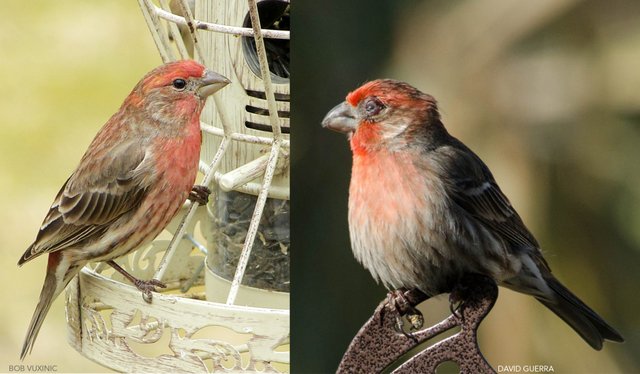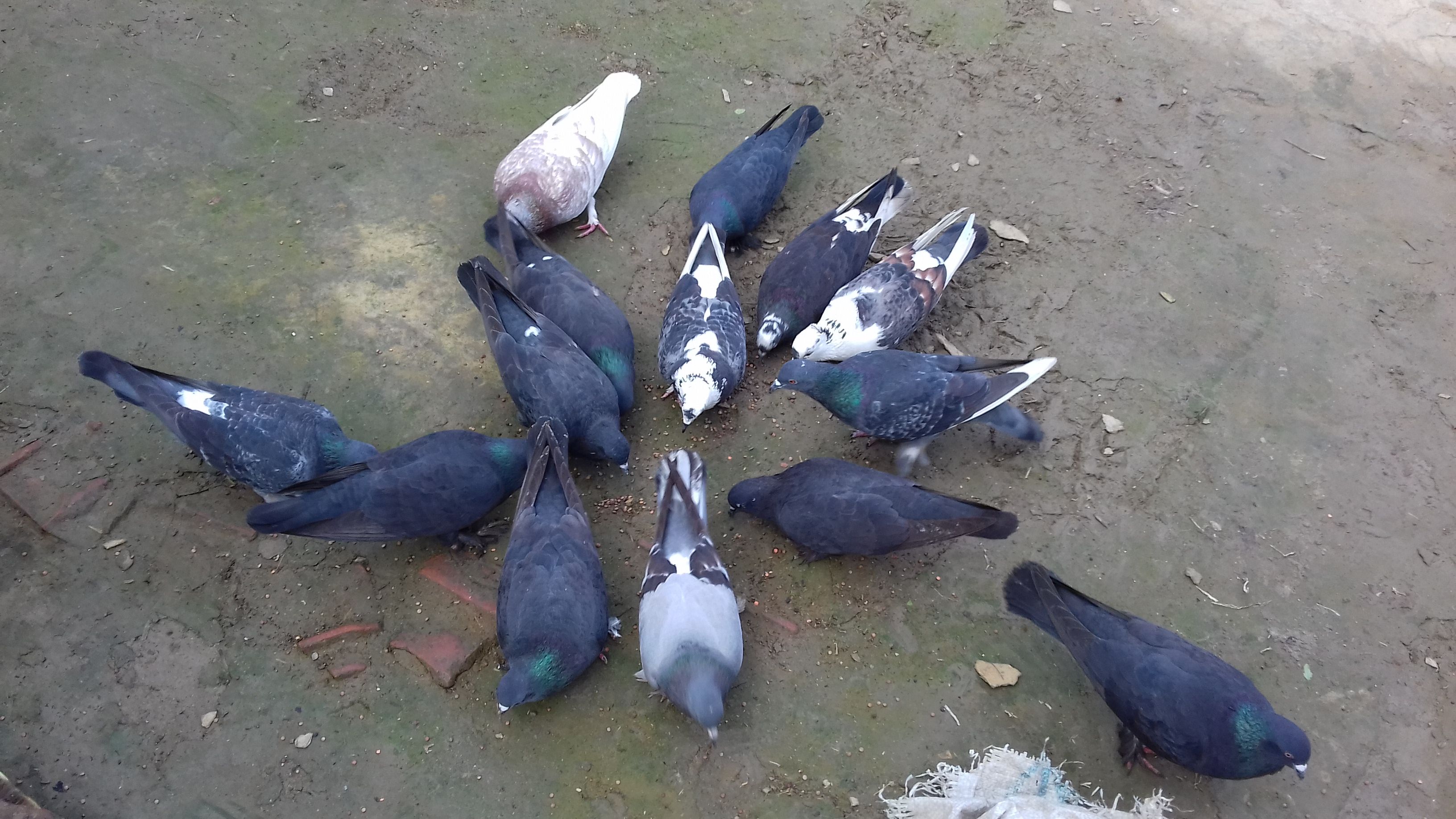FeederWatch Project participants first noticed House Finch eye disease in the Washington D.C. area in 1994. In 1994 the Cornell Lab of Ornithology started the House Finch Disease Survey to study the spread and prevalence of the eye disease across North America. In 2008 the stand-alone House Finch Disease Survey was ended and merged into Project FeederWatch.
House Finch
House Finches were only found in western North America until the 1940's. In the pet trade House Finches were known as "Hollywood Finches". When the illegal sale of "Hollywood Finches" was stopped in pet stores, the House Finches were released into the wild. As the released birds bred the population of House Finches quickly spread throughout eastern North America.

Image Source
Range Map
House Finches now range year-round from coast-to-coast across the United States.

Image Source
House Finch Eye Disease
House Finch eye disease, Mycoplasmal conjunctivitis, is caused by a unique parasitic bacterium strain, Mycoplasma gallisepticum.

Infected House Finches have red, swollen, runny, or crusty eyes. The disease can cause the eyes to become swollen shut and lead to blindness in extreme cases.
Spread of the Disease
Mycoplasma gallisepticum has been known as a pathogen of domestic chickens and turkey. The disease has also affected other wild bird species including the Purple Finch, American Goldfinch, and Evening Grosbeak.
The eye disease has mainly affected the eastern population of House Finches. However in 2006, the disease was found west of the Rocky Mountains.
Citizen scientists participating in Project FeederWatch are providing researchers the data needed to study and monitor the spread of the disease.

Image Source
Increase Virulence
While some infected House Finches recover, many birds dies from predation, exposure, or starvation.
Previously infected House Finches develop an "immune memory" that helps to prevent reinfection of the disease. However, researchers are learning that the immune memories of House Finches are not always perfect.
Mycoplasma gallisepicum is becoming stronger and more dangerous that in previous years. Researchers have found that lapses in immune memory allow more virulent strains of Mycoplasma gallisepicum to survive. And when passed on to the next host the newly infected House Finch becomes even sicker. Researchers have determined the stronger strains of Mycoplasma gallisepicum are almost twice as deadly.
Sources and Full Articles
House Finch, All About Birds
House Finch Eye Disease, Project FeederWatch, The Cornell Lab of Ornithology
House Finch Eye Disease: Increased virulence as disease progresses, Project FeederWatch, The Cornell Lab of Ornithology, 4 April 2018
Incomplete Host Immunity Favors the Evolution of Virulence in an Emergent Pathogen, Science, 2 March 2018, Vol. 359, Issue 6379, pp. 1030-1033
Thank You!
Thank you!
she looks like the " hollywood finches " :)
Downvoting a post can decrease pending rewards and make it less visible. Common reasons:
Submit
That's scary and depressing! Poor little birds! Good article, in spite of that sad news. People don't think what they're doing when they release things into the wild.
Downvoting a post can decrease pending rewards and make it less visible. Common reasons:
Submit
informative discussion ..about the diseases.
thanks for awareness about this diseases
Downvoting a post can decrease pending rewards and make it less visible. Common reasons:
Submit
Beautiful post great shots you shared and nice information along :)
Downvoting a post can decrease pending rewards and make it less visible. Common reasons:
Submit
Very informative post @etcmike, I thought conjunctivitis is a human disease only. Unfortunately, many of bacterias become stronger due to pollution and it's more likely many diseases appear in the next years. Great post :D
Raquel
Downvoting a post can decrease pending rewards and make it less visible. Common reasons:
Submit
I also believe pollution can be responsible for degrading the immune system which also makes diseases more serious.
Have a fantastic week!
Steem on,
Mike
Downvoting a post can decrease pending rewards and make it less visible. Common reasons:
Submit
That's totally true, I agree with you.
Downvoting a post can decrease pending rewards and make it less visible. Common reasons:
Submit
Great pictures as always!
Downvoting a post can decrease pending rewards and make it less visible. Common reasons:
Submit
Downvoting a post can decrease pending rewards and make it less visible. Common reasons:
Submit
Thanks
Downvoting a post can decrease pending rewards and make it less visible. Common reasons:
Submit
Beautiful photography of the bird... I am happy that you have done so much research.👍
Downvoting a post can decrease pending rewards and make it less visible. Common reasons:
Submit
deleted
Downvoting a post can decrease pending rewards and make it less visible. Common reasons:
Submit
very beautiful birds I really like friends.
Downvoting a post can decrease pending rewards and make it less visible. Common reasons:
Submit
I love birds......

Downvoting a post can decrease pending rewards and make it less visible. Common reasons:
Submit
Great post. Birds are really precious as they add music to nature.
Downvoting a post can decrease pending rewards and make it less visible. Common reasons:
Submit
Great photography..
Nice photoshot..
Downvoting a post can decrease pending rewards and make it less visible. Common reasons:
Submit
beautiful birds @etcmike
Downvoting a post can decrease pending rewards and make it less visible. Common reasons:
Submit
beautiful bird with elegant color, melodious voice, thanks for sharing, @etcmike.
Downvoting a post can decrease pending rewards and make it less visible. Common reasons:
Submit
You got a 14.50% upvote from @slimwhale courtesy of @etcmike!
Downvoting a post can decrease pending rewards and make it less visible. Common reasons:
Submit